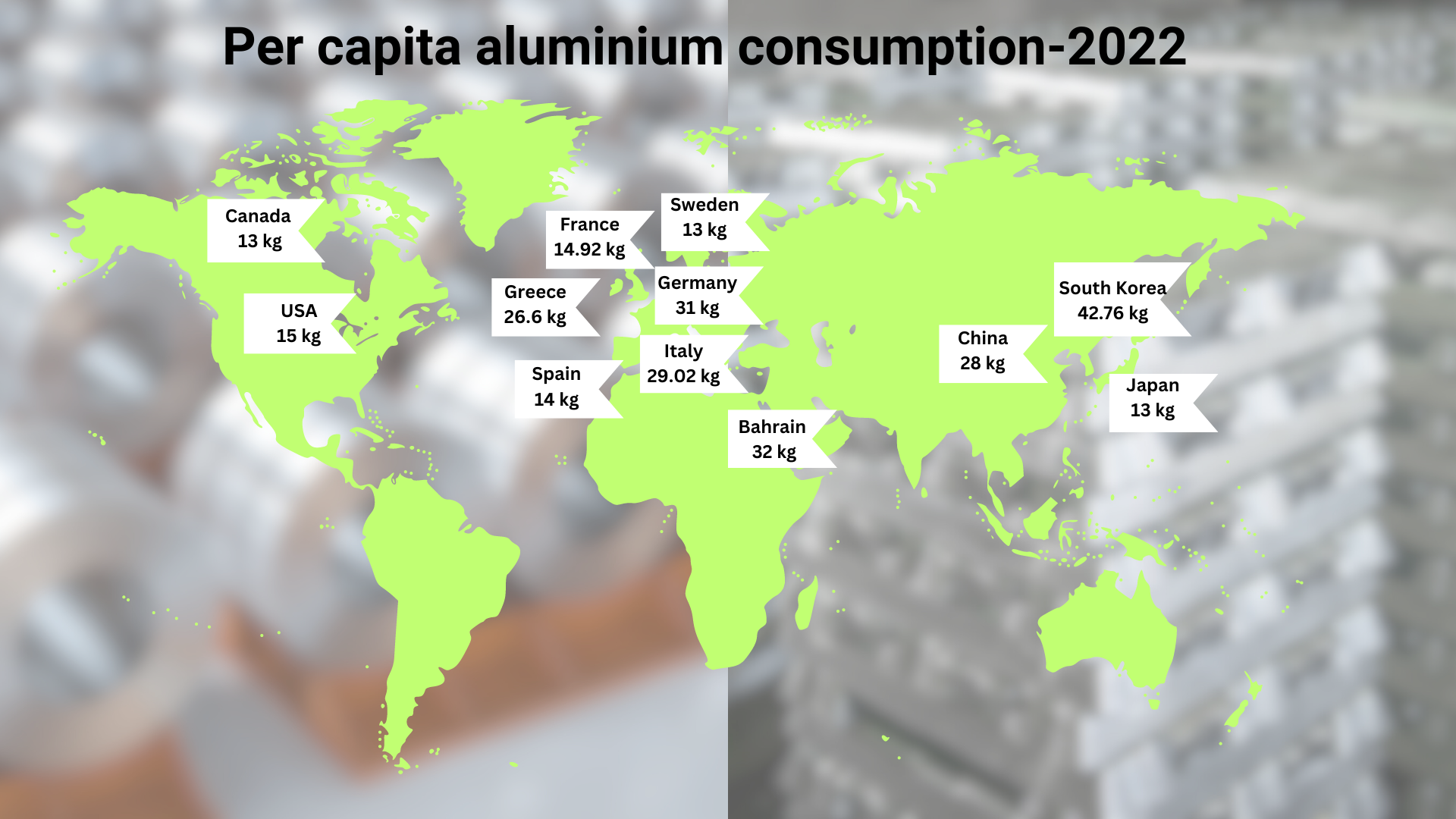

Aluminium, known for its versatility and widespread applications, is a crucial metal in various industries, from construction and transportation to packaging and aerospace. Understanding the demand for aluminium consumption across different countries provides valuable insights into their industrial development and economic growth. In this context, examining per capita aluminium consumption reveals the extent to which nations incorporate aluminium into their daily lives. This article explores the top 10 countries ranked by per capita aluminium consumption, shedding light on their utilization of this vital metal and its implications for their economies and industrial sectors.

Per capita consumption: 42.76 kg
According to OECD estimates, South Korea's per capita aluminium consumption will be the highest globally by 2023, thanks to its expansive automobile and electrical sectors. As of 2022, South Korea's per capita aluminium consumption is 42.76 kg. However, because South Korea is not one of the top aluminium-producing countries, imports fill its metal requirement. In 2021, the country's aluminium imports were $8.46 billion, with aluminium scrap accounting for most of the total. Despite efforts to increase domestic production, South Korea's supply limits continue to compel a substantial reliance on imports.
Per capita consumption: 32 kg
Bahrain is a worldwide aluminium heavyweight, with a per capita consumption of 32 kg, ranking second on our list of aluminium consumption by country. Aluminium companies in the kingdom, particularly Aluminium Bahrain (Alba), one of the world's largest aluminium smelters, contribute considerably to local consumption. Bahrain is self-sufficient in aluminium, producing 1.6 million tonnes locally. Government measures and policy assistance, such as infrastructure, technology, and human resources investments, have aided Bahrain's aluminium industry's expansion.
Per capita consumption: 31 kg
In 2022, Germany's per capita aluminium consumption was 31 kilograms. Because of the country's poor domestic aluminium production, this significant amount is derived from imports. Because consumption exceeds production, the country's aluminium imports will be among the highest in the world in 2022, at $26.69 billion. Such reliance on imports emphasises the country's global aluminium markets for the German automobile and construction industries. As a result, international trade dynamics significantly impact Germany's industrial output and economic performance. Recycling impacts Germany's aluminium sector as recycled aluminium accounts for a significant amount of the raw material used in manufacturing aluminium.
Per capita consumption: 29.02 kg
The OECD reports that in 2022 Italy's per-capita aluminium consumption was 29.02 kilogrammes. This per-person usage is crucial to the country's expanding reliance on metal. By 2026, it is anticipated that Italy's aluminium imports will total $7.9 billion. Such consumption reflects the nation's booming manufacturing industries, which include the construction, packaging, automobile, and electronics industries.
Per capita consumption: 28 kg
Regarding aluminium consumption by country, China’s is 28 kilograms per capita, indicating a substantial demand for this non-ferrous metal within the populous nation. Crucially, China bases its aluminium market on domestic sources for this demand, with its annual aluminium mining production reaching a remarkable 40 million metric tons. While China mines 58 per cent of the global aluminium metal, it also consumes around 57 per cent.
Per capita consumption: 26.6 kg
In Greece, aluminium's average per capita consumption is roughly 26.6 kg. Due to its nominal production, the country relies heavily on overseas imports of raw and processed aluminium to supply this enormous need. Greece's aluminium imports are expected to reach $1.3 billion by 2026.
Per capita consumption: 15 kg
The average per capita aluminium consumption in the United States was 15 kg. This number depicts the complicated interaction between consumption patterns, such as industrial uses and recycling activities. Although some of this demand is supplied domestically, the United States needs to import significant aluminium from Canada and China.
Per capita consumption: 14.92 kg
France's per capita aluminium consumption was recorded at 14.92 kg, primarily due to the country's expanding and popular automobile industry. The limited local bauxite production of France, like that of many other significant consumers of aluminium, is dependent on imports to meet demand. In 2022, France imported $9.82 billion of aluminium from countries including Germany and India.
Per capita consumption: 14 kg
Spain's per capita aluminium consumption was recorded at 14 kg. The majority of this aluminium is imported from three countries: Bahrain, Iceland, and the United Arab Emirates (UAE). These countries are strategic choices because of their great productive capacities, stability, and competitive pricing.
Per capita consumption: 13 kg
In Canada, per capita aluminium consumption is estimated at 13 kilograms annually. Due to the nation's 3 million tonnes production of aluminium from smelters in 2022, this amount is primarily sourced from domestic production. A significant portion of Canada's aluminium demand is also satisfied by North America's largest aluminium smelter, which has a refining capacity of 0.629 million tonnes.
10. Japan
Per capita consumption: 13 kg
Japan's per capita aluminium consumption has attained 13 kg annually. Japan, the third-largest economy in the world, depends on imports of aluminium to meet this need because of limitations on domestic production. The country's sophisticated automobile industry's material requirements caused its aluminium imports to soar to a record-breaking $10.57 billion in 2022.
10. Sweden
Per capita consumption: 13 kg
Despite not being a major aluminium producer, Sweden is undoubtedly one of the market's significant users. Sweden is anticipated to import most of its 13 kg per capita aluminium consumption due to its need for more local production capacity. The scarcity of aluminium impacts the import dependence, and reports indicate that by 2026, Sweden will import $2.1 billion of aluminium.
Conclusion
These top 10 per capita aluminium consumption countries exemplify the global demand and reliance on this versatile metal. From towering skyscrapers to intricate machinery, aluminium plays a pivotal role in shaping the modern world. As these nations prioritize sustainability, innovation, and economic growth, their unwavering consumption of aluminium is a testament to its indispensable value. Together, they form a collective force, forging a path towards a brighter and more aluminium-intensive future.
Source: OECD/Yahoo



Responses






